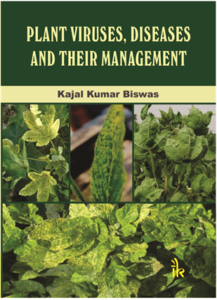Plant Viruses, Diseases and Their Management
The book is a praiseworthy attempt, comprehensively covering the theoretical and practical aspects of plant viruses and diseases caused by them. It provides a thorough insight into the molecular aspects of the pathogenic behaviour of the plant viruses and their management. Viruses are (economically) very important for most food & commercial crops worldwide. Plant virology as a subject is being taught & researched very much in India due to colossal economic losses to many of the commercial crops.
Certainly the book would generate sufficient interest among the readers (Students & teachers) on fundamental and advanced aspects of plant virology besides providing an essential understanding on molecular biology of plant viruses and diseases.
Discipline of plant viruses has developed exponentially in the recent few decades due to our recent understanding of their genomics. Development of techniques allowing us to clone the viruses for manipulating their genome, integrating required sequences to learn the behavior of the viruses/virions within the host.
This text book targets the entire curriculum on Plant Viruses at graduate and postgraduate levels in agriculture, botany, entomology, molecular biology and biotechnology, as well as a ready ( helpful ) reference for the scholars/ Faculty doing research work or teaching about plant viruses. Our understanding of the plant viruses improved very much because of latest developments in molecular biology with research on most aspects, mainly replication and interaction of viruses with their host & vectors. It provides an up to date knowledge of the plant viruses or plant virology at length and for basic understanding of their molecular biology. This book is well planned comprising 19 chapters, as per contents listed below, arranged in a logical progression for sequential & systematic learning. The text is supplemented with numerous well-labelled diagrams and appropriate color plates.
The book extensively introduces the history of plant virology, the molecular components of plant viruses, their nature and the symptoms invoked by them and physiological changes caused in the infected plants (Ch 1-3). The genome structure and organization and architecture of the virus is also dealt in detail (Ch 4 & 5) while various sub-viral agents like viroids, satellite viruses and DNAs, defective interfering DNA or RNAs in the same chapter. For logical reasons & continuity, it also covers Phytoplasma and Spiroplasma (Ch 6).An overview of the present classification and the rules for writing the names of taxonomic entities is described in detail ( Chapter 7) however, Chapter 10 deals with the description of each group of viruses so that the readers get a clear idea about the biological and molecular properties of the virus species, genera, family and order; describing briefly on the major properties of the viruses, including their taxonomic position, biology, particles, and genomes.
Details about gene expression strategies, function of virus genes, replication of RNA and DNA viruses, molecular mechanism of virus movement and distribution in the plants are presented in Ch 11-13.
Description of mechanisms for evolution of plant virus strains, and different criteria for determination of the strains are detailed (Chapter 14). The Chapter 15 deals with identification, isolation and purification procedures for viruses and their detection through biological and molecular methods. This chapter also provides information on virus antigens and antibodies, recent developments in antibody production, different forms of ELISA, and information on the recent developments of several protein- and nucleic acid-based diagnostic methods and their technological advances. It also includes /describes the latest diagnostic techniques in plant virology like ELISA, electron microscopy, DIBA, nucleic acid hybridization, etc. This chapter also highlights enormous versatility and significant use of polymerase chain reaction (PCR) and its different forms.
The virus transmission by insects, nematodes, and fungi as well as through seeds and advancements in understanding the virus-vector interaction for transmission are described in Chapters 8 & 9. The related aspect of plant virus ecology and epidemiology are treated well in Chapter 16 to give an idea for management of the virus diseases. A description of virus and virus-like diseases in economically important crop
Diseases in India and neighboring countries, their symptoms, nature of virus(es) and spread as well as their management are dealt with in Chapter 17. Further, Chapter 18 is devoted to miscellaneous general information on strategies for management of viruses in crops, natural resistance, biotechnological approaches of pathogen-derived resistance, RNA-mediated resistance, genetically engineered resistance etc.
Advanced techniques in plant virology for detection, characterization and nucleotide sequence analysis of the viruses are also dealt with in Chapter 19.
In view of the above facts, the present book provides clear insight about general and molecular aspects on pathogenic nature of the plant viruses. References are also given to enable the students to acquire even further more information on the targeted viruses & related matters for studying them professionally.
Summing up, the book is very impressive from the point of contents, presentation and quality of production. Therefore I recommend every student for having a personal copy to use. _____________________________________________________________________________
By Dr Kajal Kumar Biswas, Principal Scientist, Div Pl Pathology, IARI, New Delhi
Publisher: IK International, N Delhi, 2017. ISBN: 978-93-84588-81-6, 632 pp.
Prof (Dr) SMPaul KHURANA, Professor of Biotechnology, AIB
Head, Univ. Science Instrumentation Centre,
Ex. Dean, Faculty of Science, Engineering & Technology,
Amity University, Haryana, Gurgaon, Manesar-122413

